文房四宝英语介绍共18页
- 格式:ppt
- 大小:2.58 MB
- 文档页数:18
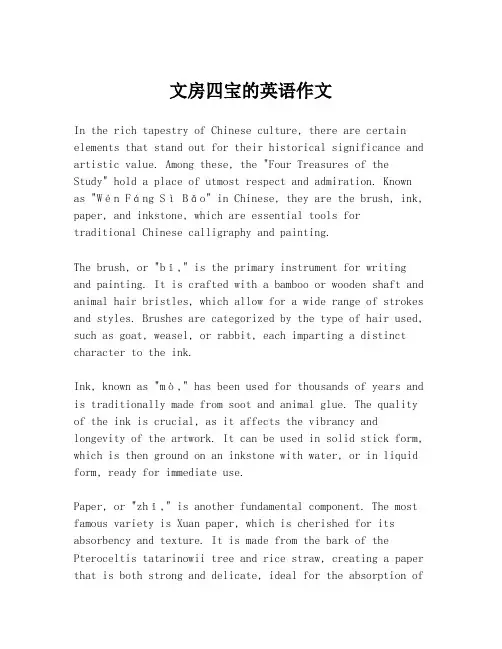
文房四宝的英语作文In the rich tapestry of Chinese culture, there are certain elements that stand out for their historical significance and artistic value. Among these, the "Four Treasures of the Study" hold a place of utmost respect and admiration. Known as "Wén Fáng Sì Bǎo" in Chinese, they are the brush, ink, paper, and inkstone, which are essential tools fortraditional Chinese calligraphy and painting.The brush, or "bǐ," is the primary instrument for writing and painting. It is crafted with a bamboo or wooden shaft and animal hair bristles, which allow for a wide range of strokes and styles. Brushes are categorized by the type of hair used, such as goat, weasel, or rabbit, each imparting a distinct character to the ink.Ink, known as "mò," has been used for thousands of years and is traditionally made from soot and animal glue. The quality of the ink is crucial, as it affects the vibrancy and longevity of the artwork. It can be used in solid stick form, which is then ground on an inkstone with water, or in liquid form, ready for immediate use.Paper, or "zhǐ," is another fundamental component. The most famous variety is Xuan paper, which is cherished for its absorbency and texture. It is made from the bark of the Pteroceltis tatarinowii tree and rice straw, creating a paper that is both strong and delicate, ideal for the absorption ofink without smudging.The inkstone, "yàn," is a flat, smooth stone, usually made from slate or ceramic, where the ink stick is ground with water to create liquid ink. It is not only a practical tool but also a piece of art, often carved with intricate designs and inscriptions.Together, these four treasures form the backbone oftraditional Chinese calligraphy and painting, which are considered not just arts but also a form of spiritual practice and personal cultivation. The act of creating with these tools requires patience, discipline, and a deep connection with the materials, reflecting the harmony between humanity and nature.In conclusion, the Four Treasures of the Study are more than just tools; they are symbols of China's profound cultural heritage. They represent the intersection of utility, artistry, and philosophy, and continue to inspire artists and connoisseurs alike in the modern age.。
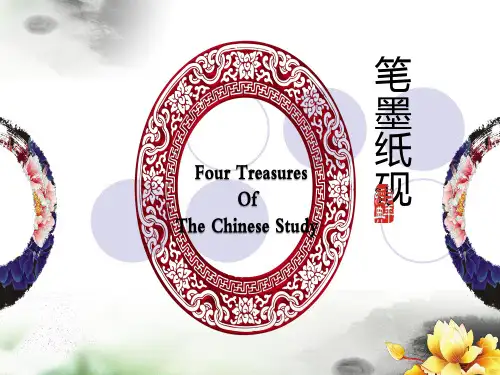
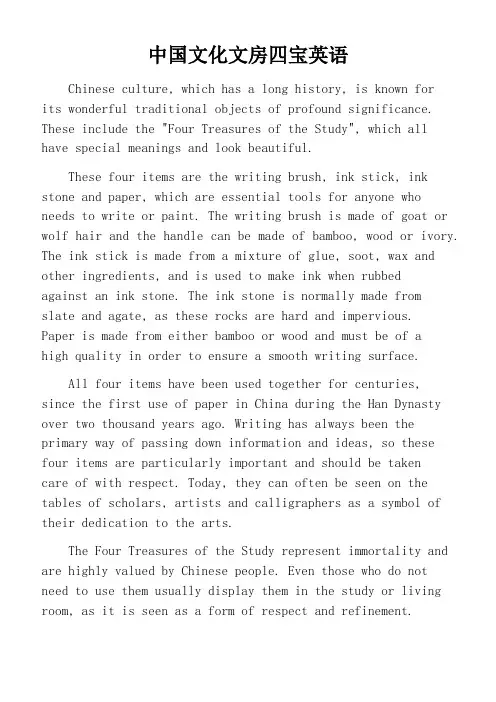
中国文化文房四宝英语Chinese culture, which has a long history, is known forits wonderful traditional objects of profound significance. These include the "Four Treasures of the Study", which all have special meanings and look beautiful.These four items are the writing brush, ink stick, ink stone and paper, which are essential tools for anyone who needs to write or paint. The writing brush is made of goat or wolf hair and the handle can be made of bamboo, wood or ivory. The ink stick is made from a mixture of glue, soot, wax and other ingredients, and is used to make ink when rubbedagainst an ink stone. The ink stone is normally made fromslate and agate, as these rocks are hard and impervious.Paper is made from either bamboo or wood and must be of ahigh quality in order to ensure a smooth writing surface.All four items have been used together for centuries,since the first use of paper in China during the Han Dynasty over two thousand years ago. Writing has always been the primary way of passing down information and ideas, so these four items are particularly important and should be takencare of with respect. Today, they can often be seen on the tables of scholars, artists and calligraphers as a symbol of their dedication to the arts.The Four Treasures of the Study represent immortality and are highly valued by Chinese people. Even those who do not need to use them usually display them in the study or living room, as it is seen as a form of respect and refinement.。
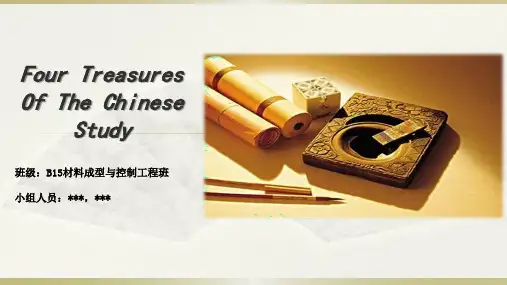
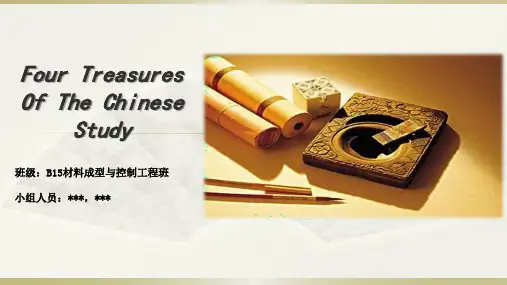


中国文化文房四宝英语The Four Treasures of the Study or "Wenfang Si Bao" is a term used to describe the four most important tools for studying, writing, and examining in Chinese culture. These four items have been an essential part of Chinese education since ancient times and are still widely used today. The four treasures of the study include the brush, ink, paper and ink stone.Brush, or bi, is perhaps the most important item in the four treasures. It is believed that the brush symbolizes wisdom and authority and makes possible the communication of ideas from one generation to the next. Generally, the brushis made from bamboo, wood, animal hair or feather, and can be either hard or soft. Hard brushes are used for painting, calligraphy, and traditional Chinese characters, while softer brushes are used for writing.Ink is the second item of the four treasures. It is made from pine soot mixed with glue and water and is the key element that helps render brush strokes into written text. There are two types of ink: solid ink sticks and liquid ink. The stick is generally ground on an ink stone, mixed with water to produce liquid ink. This mixture must be done carefully to get the right consistency. In addition, various colors of ink can be obtained by mixing different ingredients into the solution.Paper is the third item in the four treasures of the study. Paper is made from the bark of mulberry trees and has been in use since the Han Dynasty. It was during this period that the first papermaking workshop was established. Paper isused to write on and provides a good surface to capture the brush strokes. Different types of paper can be used depending on the purpose, such as rice paper for calligraphy and art pieces and thicker paper for more practical uses.The ink stone is the last of the four treasures. It is mostly used for grinding solid ink into liquid form. Inkstones can come in many different shapes and sizes, fromsmall portable ones to larger ones meant for table top use. Interestingly, ink stones were also used for divination, fortune telling and in medical diagnostics.The four treasures of the study have been used to communicate and preserve knowledge throughout Chinese history. Today they are still used in Chinese classrooms and are a reminder of the importance of education in Chinese culture.。
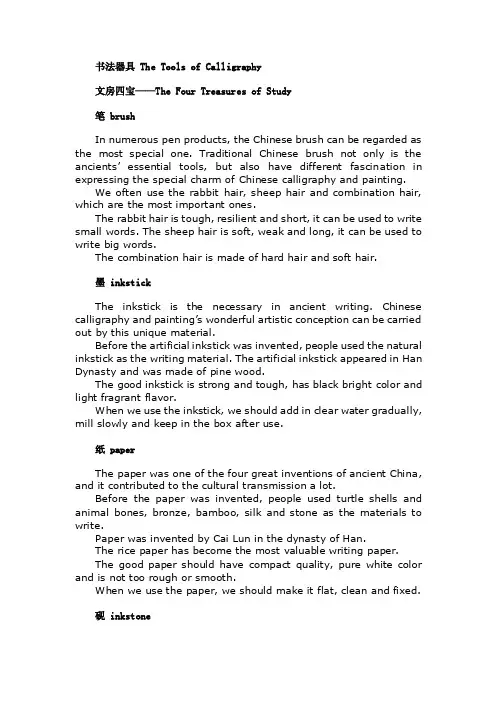
书法器具 The Tools of Calligraphy文房四宝——The Four Treasures of Study笔 brushIn numerous pen products, the Chinese brush can be regarded as the most special one. Traditional Chinese brush not only is the ancients’ essential tools, but also have different fascin ation in expressing the special charm of Chinese calligraphy and painting.We often use the rabbit hair, sheep hair and combination hair, which are the most important ones.The rabbit hair is tough, resilient and short, it can be used to write small words. The sheep hair is soft, weak and long, it can be used to write big words.The combination hair is made of hard hair and soft hair.墨 inkstickThe inkstick is the necessary in ancient writing. Chinese calligraphy and painting’s wonderful artistic conception can be carried out by this unique material.Before the artificial inkstick was invented, people used the natural inkstick as the writing material. The artificial inkstick appeared in Han Dynasty and was made of pine wood.The good inkstick is strong and tough, has black bright color and light fragrant flavor.When we use the inkstick, we should add in clear water gradually, mill slowly and keep in the box after use.纸 paperThe paper was one of the four great inventions of ancient China, and it contributed to the cultural transmission a lot.Before the paper was invented, people used turtle shells and animal bones, bronze, bamboo, silk and stone as the materials to write.Paper was invented by Cai Lun in the dynasty of Han.The rice paper has become the most valuable writing paper.The good paper should have compact quality, pure white color and is not too rough or smooth.When we use the paper, we should make it flat, clean and fixed.砚 inkstoneThe inkstone originated in Shang dynasty. There are pottery inkstone, brick inkstone and jade inkstone. The most famous inkstones are the Duan inkstone and the She inkstone.The Duan inkstone is produced in Duan state Guangdong province.The white is best, the purple is worst. The Duan inkstone is best used to write big words.The She inkstone is as famous as the Duan inkstone, which is produced in She state Anhui province. And the She inkstone is best used to write small words.When we use the inkstone, we should keep water, scrub after using and mill lightly.。
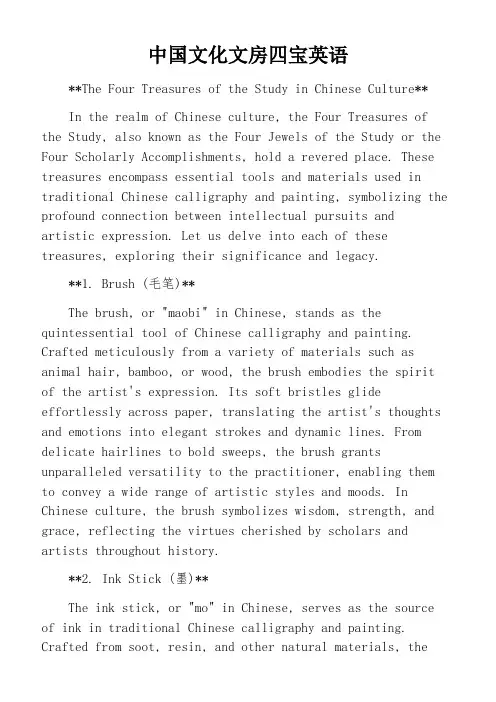
中国文化文房四宝英语**The Four Treasures of the Study in Chinese Culture**In the realm of Chinese culture, the Four Treasures of the Study, also known as the Four Jewels of the Study or the Four Scholarly Accomplishments, hold a revered place. These treasures encompass essential tools and materials used in traditional Chinese calligraphy and painting, symbolizing the profound connection between intellectual pursuits andartistic expression. Let us delve into each of these treasures, exploring their significance and legacy.**1. Brush (毛笔)**The brush, or "maobi" in Chinese, stands as the quintessential tool of Chinese calligraphy and painting. Crafted meticulously from a variety of materials such as animal hair, bamboo, or wood, the brush embodies the spirit of the artist's expression. Its soft bristles glide effortlessly across paper, translating the artist's thoughts and emotions into elegant strokes and dynamic lines. From delicate hairlines to bold sweeps, the brush grants unparalleled versatility to the practitioner, enabling them to convey a wide range of artistic styles and moods. In Chinese culture, the brush symbolizes wisdom, strength, and grace, reflecting the virtues cherished by scholars and artists throughout history.**2. Ink Stick (墨)**The ink stick, or "mo" in Chinese, serves as the source of ink in traditional Chinese calligraphy and painting. Crafted from soot, resin, and other natural materials, theink stick undergoes a meticulous process of grinding and mixing to produce a smooth, rich ink. Symbolizing the essence of creativity and depth, ink embodies the artist's spirit and imagination, flowing freely from the brush onto paper. The act of grinding ink is not merely a preparatory step but a ritualistic practice, fostering a deep connection between the artist and their craft. In Chinese culture, the ink stick represents integrity, perseverance, and the transformative power of artistry.**3. Paper (宣纸)**Paper, or "xuanzhi" in Chinese, serves as the canvas for calligraphy and painting, providing a surface for the artist to express their vision. Renowned for its absorbency, durability, and smooth texture, xuan paper is crafted from the bark of the sandalwood tree, meticulously processed to achieve its distinctive qualities. Each sheet of papercarries a history of craftsmanship, embodying the centuries-old traditions of Chinese artistry. From the delicate fibers to the subtle sheen, xuan paper enhances the beauty and authenticity of the artist's work, inviting viewers to immerse themselves in its timeless elegance. In Chinese culture, paper symbolizes purity, resilience, and the boundless potential of creativity.**4. Ink Stone (砚台)**The ink stone, or "yantai" in Chinese, serves as the vessel for grinding ink, embodying the harmony between nature and artifice. Carved from stone or ceramic, the ink stone features a smooth surface where ink is ground with water to create the desired consistency. The act of grinding ink onthe stone is a meditative practice, requiring patience, precision, and a deep appreciation for the transformative power of the creative process. As the ink stone absorbs the traces of ink over time, it becomes imbued with the artist's spirit, bearing witness to their journey of exploration and discovery. In Chinese culture, the ink stone symbolizes wisdom, resilience, and the enduring legacy of artistic tradition.In conclusion, the Four Treasures of the Study represent more than mere tools; they embody the essence of Chinese culture, serving as a testament to the enduring power of creativity, intellect, and expression. From the delicate strokes of the brush to the rich hues of ink, these treasures continue to inspire generations of artists and scholars, fostering a deep appreciation for the beauty and complexity of the human experience.。
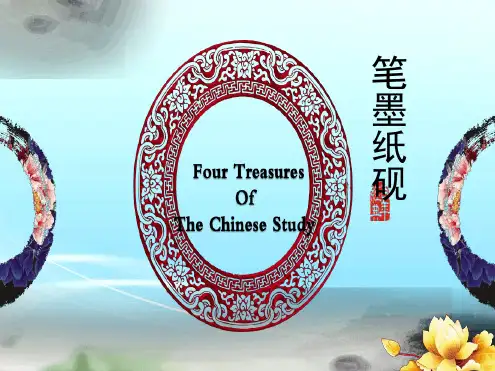
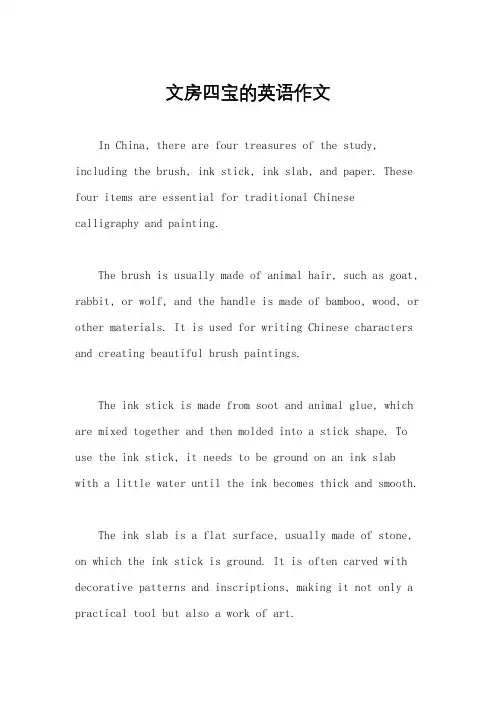
文房四宝的英语作文In China, there are four treasures of the study, including the brush, ink stick, ink slab, and paper. These four items are essential for traditional Chinesecalligraphy and painting.The brush is usually made of animal hair, such as goat, rabbit, or wolf, and the handle is made of bamboo, wood, or other materials. It is used for writing Chinese characters and creating beautiful brush paintings.The ink stick is made from soot and animal glue, which are mixed together and then molded into a stick shape. To use the ink stick, it needs to be ground on an ink slab with a little water until the ink becomes thick and smooth.The ink slab is a flat surface, usually made of stone, on which the ink stick is ground. It is often carved with decorative patterns and inscriptions, making it not only a practical tool but also a work of art.The paper used for calligraphy and painting is called Xuan paper, which is made from the bark of the sandalwood tree. It is smooth, durable, and absorbent, making it perfect for capturing the subtle nuances of brushwork and ink.These four treasures of the study are not only tools for artistic creation but also symbols of Chinese culture and tradition. They have been cherished by scholars and artists for centuries, and continue to inspire creativity and appreciation for the beauty of Chinese calligraphy and painting.。
文房四宝的英语作文The Four Treasures of the Study, also known as the Four Jewels of the Study, are the brush, ink, paper, and inkstone. These are the essential tools for traditional Chinese calligraphy and painting. The brush is made of animal hair, such as rabbit, goat, or wolf, and has a long history in China. It is used for writing and painting, and different brushes are used for different purposes.Ink is an important part of the Four Treasures of the Study. It is traditionally made from soot, mixed with glue and scented oils. The ink is ground on an inkstone with a small amount of water to produce the ink for writing or painting. The process of grinding ink is considered an art form in itself, and skilled calligraphers and painters are often admired for their ability to create beautiful ink.Paper is another essential part of the Four Treasures of the Study. Traditional Chinese paper is made from the bark of the mulberry tree and has a smooth, absorbent surface that is ideal for calligraphy and painting. Different types of paper are used for different purposes, such as rice paper for calligraphy and silk paper for painting.The inkstone is the final part of the Four Treasures of the Study. It is used to grind the ink and is often made of stone or ceramic. Theinkstone is an important tool for calligraphers and painters, and skilled artists often have a collection of inkstones for different types of ink and different styles of writing and painting.In conclusion, the Four Treasures of the Study are essential tools for traditional Chinese calligraphy and painting. The brush, ink, paper, and inkstone are each important in their own way, and skilled artists often have a deep appreciation for the history and artistry of these tools.。
中国文化文房四宝英语The Four Treasures of the Chinese Study, or Chinese cultural artifacts known as the Four Treasures, are essential tools for a Chinese scholar. They are the writing brush (笔bǐ), ink stick (墨mò), paper (纸zhǐ), and an inkstone (砚yàn).Writing Brush: Writing brushes are made by tying together animal hair, usually rabbit or weasel, at one end of a long handle. It is the writer’s most important tool, allowing her or him to express their thoughts on paper.Ink Stick: An ink stick is a solidified ink that is composed of lamp black, glue, and water. Ink sticks come in many different shapes and sizes, from small circular ones to flat rectangular ones. The Chinese artist grinds the inkstick over the inkstone with water until it has been mixedinto liquid ink.Paper: Paper was first invented in China about 2,000years ago. It is made from natural fibers like bamboo, hemp, and even tree bark. Paper has evolved over the centuries,with innovations like silk paper helping the Chinese to communicate their ideas more effectively.Inkstone: The inkstone is an essential tool for grinding the ink stick over and mixing it with water. It is typically made from stone or clay and comes in various shapes and sizes.These four items have been used by Chinese scholars for centuries and they remain essential tools in Chinese writing and art today. Their use harkens back to ancient times, representing a shared history and cultural identity.。
文房四宝的英语作文The four treasures of the study, also known as the four jewels of the study, are essential tools for traditional Chinese calligraphy and painting. They consist of the brush, ink stick, ink slab, and paper.The brush is made of animal hair, such as rabbit, weasel, or wolf, and is used for writing and painting. It comes in various sizes and shapes, each suited fordifferent styles of calligraphy and painting.The ink stick is made from soot and glue, and is usedto create ink when rubbed against an ink slab with water. The quality of the ink stick is crucial for producing smooth and durable ink.The ink slab is a flat surface made of stone or ceramic, and is used for grinding the ink stick with water toproduce ink. It is often carved with intricate designs and patterns, and is considered a work of art in itself.The paper used for calligraphy and painting is typically made from rice or bamboo fibers. It is thin, strong, and absorbent, allowing the ink to spread evenly and smoothly across its surface.The four treasures of the study are not only tools for artistic expression, but also symbols of Chinese culture and tradition. They have been cherished and revered for centuries, and continue to hold a special place in the hearts of artists and scholars around the world.。